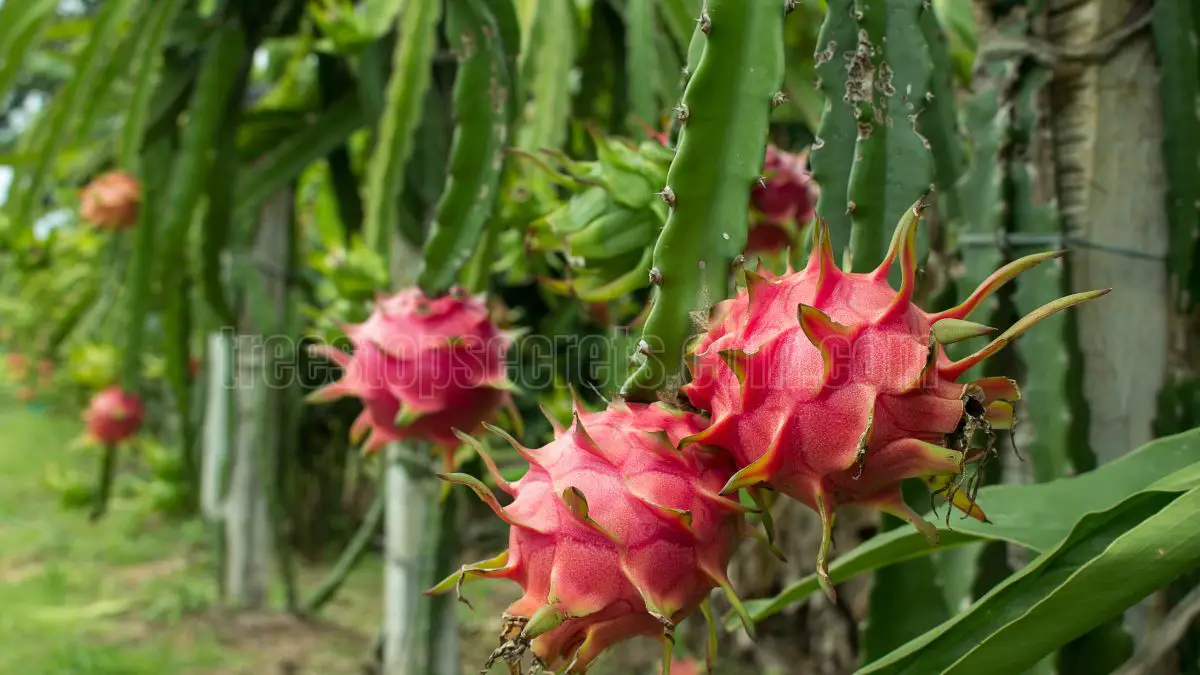Once you learn how to grow a dragon fruit plant, you’ll find it’s an enjoyable and productive project. It produces sweet fruit and adds to the special beauty of your garden. This unique tropical cactus grows best in balmy, tropical climates.
As such it is ideal for places such as Southern California, where temperatures seldom dip below 50°F. The most important components to successfully growing dragon fruit are having well-drained soil and lots of sun. Provide a strong support system, since the plant can grow tall and vine-like.
Consistent watering and fertilization a couple of times a year will encourage healthy growth and fruiting. In this guide, we’ll walk you through everything you need to know to grow your own dragon fruit plant. With the right care you can be treated to its colorful blooms and juicy fruit for many years.
Key Takeaways
- Dragon fruit plants are usually grown in tropical or subtropical environments and require at least 6 hours of sun each day. Select a site where they can get full sun but the plants are shielded from prevailing winds and bitter cold.
- Opt for well-draining soil that’s high in organic matter to encourage robust root growth. Always check the soil pH and make sure it is between 6.0 and 7.0 for best growth.
- When you do water your dragon fruit, soak the soil thoroughly and then don’t water again until the top inch of the soil feels dry. Give your dragon fruit an initial soaking, then adjust your watering routine to accommodate seasonal changes and rainfall patterns.
- Use high-nitrogen organic fertilizers throughout the growing season, but don’t over-fertilize or your dragon fruit plant may experience nutrient burn. Consistently prune the plant to get rid of dead or dying stems and increase fruit production.
- Dragon fruit plants are famous for being climbers, so build a strong support system that can handle outdoor elements.
- As with any plant, stay aware of pests and diseases, establishing a watering and soil routine to avoid problems. Watch the plants closely and adjust care according to their health and your local environment.
How to Grow a Dragon Fruit Plant
Growing a dragon fruit plant, or pitaya, is fun and easy to do. This exciting tropical fruit has eye-catching fuchsia skin and sugary, white pulp. It only blooms under the right circumstances that are essential to its development.
Learn the proper climate, soil, watering, and overall plant care needs, and you’ll be rewarded with a bountiful harvest. Here are the most important things to keep in mind when growing this truly exotic plant.
1. Identify Ideal Climate and Light Conditions
Dragon fruit plants prosper in warm, tropical or subtropical environments. They need to be grown in full sun, preferably with at least six hours of direct light per day. This light is important for the process of photosynthesis, which directly impacts the plant’s growth and ability to produce fruit.
To ensure optimal growth, consider locating your dragon fruit in an area shielded from high winds. Make sure it’s protected from temperature fluctuations, too. For those living in hotter climates, keeping your dragon fruit plant partially shaded during the worst of the afternoon sun’s intensity can help protect against sunburn.
A properly determined location provides good conditions for growth and protects the plant from stressors, such as too much wind or sun.
2. Prepare and Amend Soil for Optimal Growth
Soil is an important factor in growing dragon fruit. The best soil for dragon fruit is well-draining and rich in organic matter. If your soil is heavy and does not drain well, making it difficult for roots to grow, be sure to amend this type of soil with compost or peat moss.
This practice reduces compaction, increases nutrient-holding capacity, and supports biological activity, all of which benefit drainage. Soil pH test is another crucial step as well. The ideal pH range for dragon fruit plants should be slightly acidic to neutral, or between 6.0 and 7.0.
If your soil is too alkaline, you can lower the pH with added sulfur. If it’s very acidic, add lime to the soil to increase the pH.
3. Establish Effective Watering Routines
Proper watering routines are vital to the overall plant health of dragon fruit plants. Water thoroughly but only occasionally to ensure strong root development. This technique replicates the plant’s natural environment and encourages robust root growth. Let the first inch of sandy cactus soil dry out before watering again to promote a good fruit crop.
Temperature and precipitation changes throughout the year will affect how often you need to water your plants. In the peak of summer, you’ll want to water your dragon fruit cultivars more frequently. During the fall and winter months, lessen the amount of water as the plants will be going into dormancy.
Once outside temperatures drop below 65°F, consider bringing your delicate dragon fruit cutting inside where they will be safe from frost.
4. Choose the Right Fertilizers and Amendments
Dragon fruit plants are heavy feeders, especially during their first year. A high-nitrogen organic fertilizer is ideal to encourage the fast development. Fertilizers with this nutrient ratio will deliver 20-20-20, for example.
Fertilizer should be applied in the growing season, which generally occurs in the spring and summer, to promote robust growth. Moderation is important. Too much fertilizer can cause nutrient burn, which can have a negative impact on plant health.
Applying fertilizers and amendments at the suggested rates will provide your dragon fruit plant with the nutrients it needs while minimizing the chance of harming the plant.
5. Explore Propagation Techniques for Success
The easiest and most dependable way to propagate dragon fruit is with cuttings. This technique usually takes less time than cultivating the fruit from seeds. To propagate, choose a strong cutting that is 12-18 inches long.
First, allow the cutting to callus over in a dry, shaded area for 7 to 10 days. From there, you can pot it up into some well-draining soil. The steps for propagation can be summarized as follows:
- Select a healthy cutting.
- Let it callus in a dry, shaded spot.
- Plant in prepared, well-draining soil.
- Water lightly after planting.
Using this technique, you can expect a harvest in one to three years. It is the perfect plant for all of you impatient fruit lovers out there!
6. Design a Support System for Growth
As a climbing cactus, dragon fruit needs an extensive support system to grow. Building a trellis or using a sturdy post will give you the support needed for upward growth. Make sure the support structure is high enough to allow for the plant’s upward growth.
Choosing materials that are designed for long-lasting outdoor use is important. This structure not only provides support, but helps to train the plant for optimal growth. It helps contain it and keeps it from getting unruly and scraggly and ensures it shoots off with great growing.
7. Recognize Common Pests and Diseases
Preventing and controlling common pests and diseases is essential in keeping your dragon fruit plant healthy. Common pests such as mealybugs and scale insects can be destructive if not regularly controlled. Regularly checking the plant for signs of infestation will make it easier to step in early on.
Diseases like root rot and fungal infections are additional hazards. Taking preventive measures, like avoiding overwatering and ensuring good soil drainage, will greatly minimize these dangers. Vibrant, well-tended plants will have a much easier time fighting off invading pests and diseases, resulting in more fruit.
8. Implement Pruning for Health and Production
Regularly pruning a dragon fruit plant will help it grow healthier and produce better fruit. This practice is important for removing dead or damaged stems, promoting bushier growth, and improving fruit production. Removing side shoots helps the plant focus its energy on developing greater fruit, improving its yield.
Pruning tips include:
- Timing: Prune during the growing season.
- Tools: Use clean, sharp pruning shears.
- Techniques: Make clean cuts just above a node to promote healthy regrowth.
9. Mitigate Extreme Weather Effects
Extreme weather can damage dragon fruit plants. When a cold snap does occur, keeping plants from being damaged by frost is critical. Protecting them with fabric or bringing potted plants inside can save them from frost harm.
On the other hand, in extreme hot spells, having shade will keep your plants from wilting. Applying mulch helps insulate soil, keeping it cooler in summer and warmer in winter while holding in moisture, reducing stress and improving growing conditions on the whole.
10. Adapt to Regional Microclimates
Getting to know the weather patterns in your area will go a long way in establishing appropriate dragon fruit plant care routines. Choosing where to plant your dragon fruit according to where it will be naturally protected from the elements will improve growth and prevent the plant from unnecessary stress.
Planting in containers is another smart choice, giving you the ability to move them as necessary in a shifting climate. Container growing dragon fruit grows best in a five-gallon container that’s at least 10 to 12 inches deep. Ensure it has enough drainage holes for best growth!
Dragon Tree Plant Care
Dragon tree (Dracaena marginata) care requires regular attention to the plant’s particular requirements to promote vigorous growth, similar to how growers nurture dragon fruit cacti. With a little bit of care and attention to watering, lighting, and pest control, this drought-tolerant plant flourishes.
1. Understand Watering Needs for Dragon Trees
Water dragon trees once the top 1-2 inches of soil have dried out. This can be a process of up to three weeks or more. Do not allow your dragon tree to sit in water, which can cause root rot.
Increase how often you water if you live in a particularly dry indoor climate.
2. Optimize Light Preferences for Indoor Growth
To ensure healthy growth, place dragon trees where they’ll receive bright, indirect light. They like bright, direct light so a sunny room with exposure to the south or west is perfect.
To counteract this, rotate your plants every few months so they’re receiving light from all sides. Consider these conditions:
- Low light: Limited growth
- Medium light: Moderate growth
- High light: Best for vibrant health
3. Address Common Pests and Diseases in Dragon Trees
Check often for common pests like spider mites and aphids. Deal with any infestations immediately with insecticidal soap or neem oil.
Keeping proper air flow around your tree will go a long way against fungal infections, which enjoy still air.
Best Practices for Indoor Dragon Plant Cultivation
With proper care and attention, your dragon fruit plants will thrive indoors, especially in a good drainage gardening pot. This includes providing the right amount of light, humidity, and temperature to ensure abundant fruit production and maintaining overall plant health.
1. Master Potting Techniques for Indoor Growth
Choose pots with drainage holes to avoid water accumulation, a typical frustration that can stall development. Using a combination of potting soil and perlite provides better aeration, so roots can breathe.
To keep your indoor dragon plant healthy and thriving, repot it every two or three years to replace depleted soil with fresh nutrients.
2. Maintain Ideal Humidity Levels
Go for a humidity range of 40-60%, which is perfect for dragon plants. Consider using a humidifier, or set up a pebble tray to increase humidity levels indoors.
Monitor humidity conditions with a hygrometer to keep humidity levels optimal.
3. Consider Temperature Variations for Indoor Plants
As a tropical plant, dragon plants thrive in warm climates, ideally between 65-85°F indoors. Avoid placing plants in areas with excessive draft or heating source, as this can lead to environmental stress.
Make seasonal temperature adjustments to keep them thriving year-round.
To keep your plant healthy, prune dead branches two to three times yearly. Fertilize every 2 months with a diluted balanced fertilizer, starting in spring and continuing through fall during the plant’s first year.
Consider providing plants with a trellis and give them at least 6 feet between plants.
Conclusion
With their vibrant colors and unique fruit, growing a dragon fruit plant is sure to enhance your environment. By learning what it requires, you can flourish right alongside it. For the happiest, most productive plant, give it lots of sunshine, well-drained soil and regular watering. Protect your dragon fruit plant. Pruning regular pruning is essential to keep your dragon fruit happy and healthy. Indoor growing is extremely possible with adequate space and light.
Experiment with different varieties and methods to find out what works best for you! With a little patience and care, you’ll be rewarded both with the beauty and flavor of this fascinating fruit. Begin your adventure today and see your plant thrive. For the seasoned gardener or the novice, dragon fruit is a unique adventure. It might just transform your gardening adventure more than ever before! Consider planting and growing one yourself!
Frequently Asked Questions
How long does it take for a dragon fruit plant to bear fruit?
How long does it take for a dragon fruit plant to produce quality fruit? Of course, factors such as the level of care and local climate, including tropical climates, affect this time frame.
What type of soil is best for dragon fruit plants?
Dragon fruit plants thrive in a sandy cactus soil with good drainage and a pH of 6 to 7, making a cactus mix or a combination of potting soil and sand ideal for proper fruit production.
How much sunlight do dragon fruit plants need?
These beauties really soak up the sun! To maximize their growth potential and ensure abundant fruit production, make sure they’re getting a minimum of 6 to 8 hours of direct sunlight each day.
Can dragon fruit be grown indoors?
You’ll be happy to know that dragon fruit cacti do very well when grown indoors! As long as you’re giving them enough light—either from a sunny window or supplemental grow lights—and keeping the watering in check, you’ll ensure good fruit crop.
How often should I water my dragon fruit plant?
Watering your dragon fruit plant requires attention to detail; water every 2 to 3 weeks while ensuring the sandy cactus soil dries out between waterings to promote overall plant health and prevent root rot.
Do dragon fruit plants need fertilizer?
Applying a balanced fertilizer can help promote overall plant health and abundant fruit production in dragon fruit plants.
Are dragon fruit plants cold-hardy?
Are dragon fruit plants cold-hardy? A note on temperature is that they do best in temperatures above 32°F. To ensure good fruit crop and protect them from frost, bring them indoors or provide proper protection.
Image Source: Paid image from CANVA




